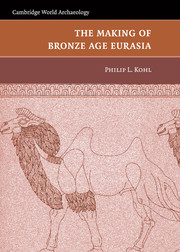Book contents
- Frontmatter
- Contents
- Illustrations and Maps
- Abbreviations
- Preface
- Frontispiece: Eurasian Steppe Zone and the Greater Ancient Near East
- 1 Archaeological Theory and Archaeological Evidence
- 2 The Chalcolithic Prelude – From Social Hierarchies and Giant Settlements to the Emergence of Mobile Economies, ca. 4500–3500 BC
- 3 The Caucasus – Donor and Recipient of Materials, Technologies, and Peoples to and from the Ancient Near East
- 4 Taming the Steppe – The Development of Mobile Economies: From Cattle Herders with Wagons to Horseback Riders Tending Mixed Herds; the Continued Eastward Expansion of Large-Scale Metallurgical Production and Exchange
- 5 Entering a Sown World of Irrigation Agriculture – From the Steppes to Central Asia and Beyond: Processes of Movement, Assimilation, and Transformation into the “Civilized” World East of Sumer
- 6 The Circulation of Peoples and Materials – Evolution, Devolution, and Recurrent Social Formations on the Eurasian Steppes and in West Asia: Patterns and Processes of Interconnection during Later Prehistory
- Appendix
- References
- Index
5 - Entering a Sown World of Irrigation Agriculture – From the Steppes to Central Asia and Beyond: Processes of Movement, Assimilation, and Transformation into the “Civilized” World East of Sumer
Published online by Cambridge University Press: 05 June 2012
- Frontmatter
- Contents
- Illustrations and Maps
- Abbreviations
- Preface
- Frontispiece: Eurasian Steppe Zone and the Greater Ancient Near East
- 1 Archaeological Theory and Archaeological Evidence
- 2 The Chalcolithic Prelude – From Social Hierarchies and Giant Settlements to the Emergence of Mobile Economies, ca. 4500–3500 BC
- 3 The Caucasus – Donor and Recipient of Materials, Technologies, and Peoples to and from the Ancient Near East
- 4 Taming the Steppe – The Development of Mobile Economies: From Cattle Herders with Wagons to Horseback Riders Tending Mixed Herds; the Continued Eastward Expansion of Large-Scale Metallurgical Production and Exchange
- 5 Entering a Sown World of Irrigation Agriculture – From the Steppes to Central Asia and Beyond: Processes of Movement, Assimilation, and Transformation into the “Civilized” World East of Sumer
- 6 The Circulation of Peoples and Materials – Evolution, Devolution, and Recurrent Social Formations on the Eurasian Steppes and in West Asia: Patterns and Processes of Interconnection during Later Prehistory
- Appendix
- References
- Index
Summary
The infiltration process of Andronovo tribes to the south was relatively slow. There are no traces of violent ends of farming settlements … The contacts between steppe and farming tribes were of a peaceful character, thereby promoting an exchange of agricultural products and crafts from the south and copper and tin from northern regions. In this case settling down and ‘dissolution’ of steppe population into that of farming oases could take place.
(Vinogradova 1994: 46)Central Asia usually refers to the extensive area south of the steppes and east of the Caspian Sea, stretching east across Xinjiang and the Dzungar Basin to the Gobi Desert of southern and Inner Mongolia nearly to the upper reaches of the Huang Ho River in Kansu province of western China proper. It is divided physically by the separate drainage systems formed by the knot of the Pamir and Tien Shan mountains into western and eastern halves, often referred to as western and eastern Turkestan. Our concern here will be principally with Middle and Late Bronze developments in western or formerly Soviet Central Asia, which today comprises the independent states of Turkmenistan, Uzbekistan, Tadjikistan, and Kyrgyzstan together with the neighboring regions of southern Kazakhstan, northern Afghanistan (north of the Hindu Kush), and Khorassan and eastern Mazanderan provinces of northeastern Iran. We will consider briefly Bronze Age developments in eastern Central Asia (principally in Xinjiang or today's westernmost China) when we discuss problems with archaeologically based ethnic and linguistic identifications at the end of this chapter.
- Type
- Chapter
- Information
- The Making of Bronze Age Eurasia , pp. 182 - 243Publisher: Cambridge University PressPrint publication year: 2007



